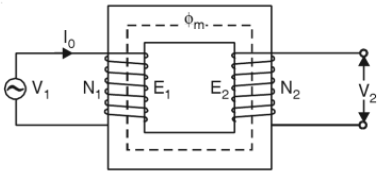1. A transformer will work on
(i) a.c. only
(ii) d.c. only
(iii) a.c. as well as d.c
(iv) none of the above
Answer: (i) a.c. only
2. The primary and secondary of a transformer are ……… coupled.
(i) electrically
(ii) magnetically
(iii) electrically and magnetically
(iv) none of the above
Answer: (ii) magnetically
3. A transformer is an efficient device because it
(i) is a static device
(ii) uses inductive coupling
(iii) uses capacitive coupling
(iv) uses electric coupling
Answer: (i) is a static device
4. A transformer transfers electrical energy from primary to secondary usually with a change in
(i) frequency
(ii) power
(iii) voltage
(iv) time period
Answer: (iii) voltage
5. The voltage per turn of the primary of a transformer is …….. the voltage per turn of the secondary.
(i) more than
(ii) less than
(iii) the same as
(iv) none of the above
Answer: (iii) the same as
6. The winding of the transformer with greater number of turns will be
(i) high-voltage winding
(ii) low-voltage winding
(iii) either high or low voltage windiny
(iv) none of the above
Answer: (i) high-voltage winding
7. A transformer does not posses ……… changing property.
(i) impedance
(ii) voltage
(iii) current
(iv) power
Answer: (iv) power
8. The iron-core is used to ……….. of the transformer.
(i) increase the weight
(ii) provide tight magnetic coupling
(iii) reduce core losses
(iv) none of the above
Answer: (ii) provide tight magnetic coupling
9. If a transformer core has air gaps, then
(i) reluctanue of magnetic path is decreased
(ii) hysteresis loss is decreased
(iii) magnetising current is greatly increased
(iv) eddy current is increased
Answer: (iii) magnetising current is greatly increased
10. The maximum flux produced in the core of a transformer is ………
(i) directly proportional to supply frequency
(ii) inversely proportional to supply frequency
(iii) inversely proportional to primary voltage
(iv) none of the above
Answer: (ii) inversely proportional to supply frequency
11. The flux in the core of a single-phase transformer is
(i) purely alternating one
(ii) purely rotating one
(iii) partly alternating and partly rotating
(iv) none of the above
Answer: (i) purely alternating one
12. A transformer is so designed that primary and secondary have
(i) high leakage reactance
(ii) large resistance
(iii) tight magnetic coupling
(iv) good electric coupling
Answer: (iii) tight magnetic coupling
13. When the primary of a transformer is connected to a d.c. supply
(i) primary draws small current
(ii) primary leakage reactance is increased
(iii) core losses are increased
(iv) primary may bum out
Answer: (iv) primary may bum out
14. An ideal transformer is one which
(i) has no losses and leakage reactance
(ii) does not work
(iii) has same number of primary and secondary turns
(iv) none of the above
Answer: (i) has no losses and leakage reactance
15. A low-voltage outdoor lighting system uses a transformer that steps 120 V down to 24 V for safety. The equivalent resistance of all low-voltage lamps is 9.6 Ω. What is the current in the secondary coil ? Assume the transformer is ideal and there are no losses in the line.
(i) 2 A
(ii) 2.5 A
(iii) 4.5 A
(iv) 1.5 A
Answer: (ii) 2.5 A
16. In the above question, what is the current in the primary coil ?
(i) 1.5A
(ii) 4.5A
(iii) 2.5 A
(iv) 0.5 A
Answer: (iv) 0.5 A
17. In Q. 15, how much power is used ?
(i) 30 W
(ii) 20 W
(iii) 60 W
(iv) 40 W
Answer: (iii) 60 W

18. Fig. 1 shows a practical transformer on no-load. The no-load current Io
(i) is in phase with V1
(ii) lags V1 by 90°
(iii) lags V1 by an angle less than 90°
(iv) leads V1 by 90°
Answer: (iii) lags V1 by an angle less than 90°
19. The no-load primary current Io Fig. 1 is
(i) wholly reactive
(ii) wholly active
(iii) partly active and partly reactive
(iv) none of the above
Answer: (iii) partly active and partly reactive
20. The no-load primary current Io is about ……… of full-load primary current.
(i) 3 – 5%
(ii) 15 – 30%
(iii) 30 – 40%
(iv) above 40%
Answer: (i) 3 – 5%